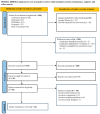Clinician- and Patient-Centred Outcomes of Digital Impressions in Infants with Cleft Lip and Palate: A Systematic Review
- PMID: 38539378
- PMCID: PMC10968856
- DOI: 10.3390/children11030343
Clinician- and Patient-Centred Outcomes of Digital Impressions in Infants with Cleft Lip and Palate: A Systematic Review
Abstract
This systematic review examines the effectiveness of digital impressions in infants with cleft lip and palate (CLP), focusing on accuracy, operator preferences, and parents' perceptions. The PICO-formulated focused questions assessed the accuracy and operator preference of digital impressions compared to conventional impressions in infants with cleft lip and palate, while also exploring parents' perceptions as patient-centred outcomes. Electronic and manual searches were conducted in five databases including PubMed, Scopus, Web of Science, Embase, and Cochrane Library; to acquire grey literature, Google Scholar was also consulted. Both experimental and observational studies that used digital impressions in the clinical care of infants with CLP were included. The Joanna Briggs Institute Critical Appraisal Checklist was used to assess the quality of the included studies. Out of 503 records, 12 studies met the inclusion criteria. The accuracy assessment included surface discrepancy and intra-arch measurements. Surface discrepancy studies showed variations in the premaxillary segments, while intra-arch measurements revealed no significant differences. Operators preferred digital impressions, citing reduced stress and streamlined workflows. Parents expressed a clear preference for digital over conventional impressions. The conclusions drawn were substantiated by weak evidence due to the limited number and the high risk of bias of the included studies. Challenges remain here, warranting continued research to enhance accuracy and assess parents' preferences, ensuring optimal outcomes for infants with CLP.
Keywords: cleft lip; cleft palate; clinicians; digital dental impression technique; infant; parents; perception; systematic review.
Conflict of interest statement
The authors declare no conflicts of interest.
Similar articles
-
The Accuracy of Digital Impressions versus Conventional Impressions in Neonates with Cleft Lip and/or Palate: A Laboratory-Based Study.Children (Basel). 2024 Jul 6;11(7):827. doi: 10.3390/children11070827. Children (Basel). 2024. PMID: 39062276 Free PMC article.
-
Exploring the potential applications of intraoral scanners in the treatment of cleft lip and palate deformity-A scoping review of literature.J World Fed Orthod. 2024 Jul 29:S2212-4438(24)00048-1. doi: 10.1016/j.ejwf.2024.06.001. Online ahead of print. J World Fed Orthod. 2024. PMID: 39079851 Review.
-
Intraoral Digital Impression Technique for a Neonate With Bilateral Cleft Lip and Palate.Cleft Palate Craniofac J. 2019 Sep;56(8):1120-1123. doi: 10.1177/1055665619835082. Epub 2019 Mar 11. Cleft Palate Craniofac J. 2019. PMID: 30857398
-
Intraoral 3D Scanning or Dental Impressions for the Assessment of Dental Arch Relationships in Cleft Care: Which is Superior?Cleft Palate Craniofac J. 2016 Sep;53(5):568-77. doi: 10.1597/15-036. Epub 2015 Dec 1. Cleft Palate Craniofac J. 2016. PMID: 26623548
-
Digital Impressions Versus Conventional Impressions in Prosthodontics: A Systematic Review.Cureus. 2024 Jan 2;16(1):e51537. doi: 10.7759/cureus.51537. eCollection 2024 Jan. Cureus. 2024. PMID: 38304652 Free PMC article. Review.
Cited by
-
The Accuracy of Digital Impressions versus Conventional Impressions in Neonates with Cleft Lip and/or Palate: A Laboratory-Based Study.Children (Basel). 2024 Jul 6;11(7):827. doi: 10.3390/children11070827. Children (Basel). 2024. PMID: 39062276 Free PMC article.
References
-
- World Health Organization WHO Human Genetics Programme, WHO Meeting on International Collaborative Research on Craniofacial Anomalies (1st: 2000: Geneva, Switzerland, 5–8 November 2000); WHO Meeting on International Collaborative Research on Craniofacial Anomalies (2nd: 2001: Park City, UT, USA, 24–26 May 2001). Global strategies to reduce the health-care burden of craniofacial anomalies: Report of WHO Meetings on International Collaborative Research on Craniofacial Anomalies. Cleft Palate-Craniofacial J. 2004;41:238–243. - PubMed
Publication types
Grants and funding
LinkOut - more resources
Full Text Sources
Miscellaneous


